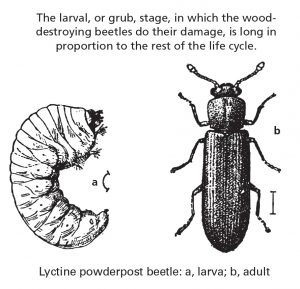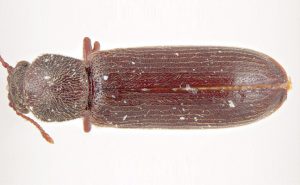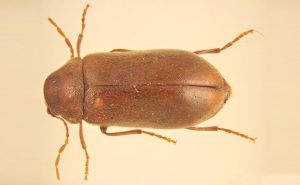Author’s Note: Information is taken from Truman’s Scientific Guide to Pest Management Operations, available online at the PMP Bookstore.

Art: North Coast Media
Lyctine true powderpost beetles (previously known as “lyctids” before being demoted to subfamily status in the family Bostrichidae) are a group of insects that pest management professionals (PMPs) often encounter during a wood-destroying insect or organism (WDI or WDO) inspection. The Guide includes a variety of these and other WDI in Chapter 9, titled “Non-subterranean Termites and Other Wood-destroying Organisms.”
Five powderpost beetle species the Guide focuses on include:
- Southern lyctus beetles (Lyctus planicollis) are found throughout the United States and Mexico, but are most common in southern and Gulf Coast states. This species is dark brown to black, and 0.25 inch long.
- Western lyctus beetles (L. cavicollis) are most common on the West Coast. Adults are rusty, red-brown in color and approximately
0.125 inch long. They commonly infest firewood, furniture and building materials in California and Oregon. - Brown lyctus beetles (L. brunneus) and European lyctus beetles (L. linearis) are distributed worldwide. They are both dark brown and have glossy, reddish-brown wing covers. The European species has been reported in ash, hickory, oak, cherry, walnut, poplar and locust wood in Eastern states, whereas the brown species are known to infest bamboo, oak and elm.
- Velvety powderpost beetles (Trogoxylon parallelopipedus) are covered with fine yellowish hairs over a rusty to black-colored body. They are found throughout the country, and may infest ash, hickory, oak and bamboo.
Management techniques
- Vapor barriers, ventilation and/or central heat to keep wood dry might be the only line of defense needed.
- If that is not the case, remove and replace infested wood where practical. Inspect adjacent wood carefully to make sure what remains is beetle-free.
- An appropriately labeled aerosol or liquid insecticide can be used to inject into the larval galleries.
- Surface treatment residual insecticides can be effective in certain cases.
- Fumigation offers good tunnel penetration, but the lack of residual can hinder its usefulness.
- Regardless of the method(s) used, make it clear to the customer that applications take time to work, and multiple applications may be necessary. Activity will cease in time as reinfestation ceases.
Lyctine or anobiid?
-
Lyctine
Photo: Pest and Diseases Image Library
-
Anobiid
Photo: Bugwood.org
Both lyctine (“true powderpost”) and anobiid (furniture and deathwatch) beetles chew small, circular emergence holes in the surface of wood. But a bulletin published by the University of Kentucky’s Entomology Department offers two tips for determining which type of beetle is the culprit:
- Insert a “click-type” ballpoint pen into the exit hole. Only the tip of the ball will fit through a lyctine beetle emergence hole. If the hole was made by an anobiid, the tip of the pen will only enter partway up the angled face of the point — even though the hole itself might be larger.
- Inspect the powder (frass) that sifts out of the exit holes. Lyctine frass is extremely fine and feels like talc when rubbed between the fingers. Anobiid frass also is powderlike, but feels gritty due to the presence of tiny fecal pellets.
Source: Entomology.ca.uky.edu


Leave A Comment